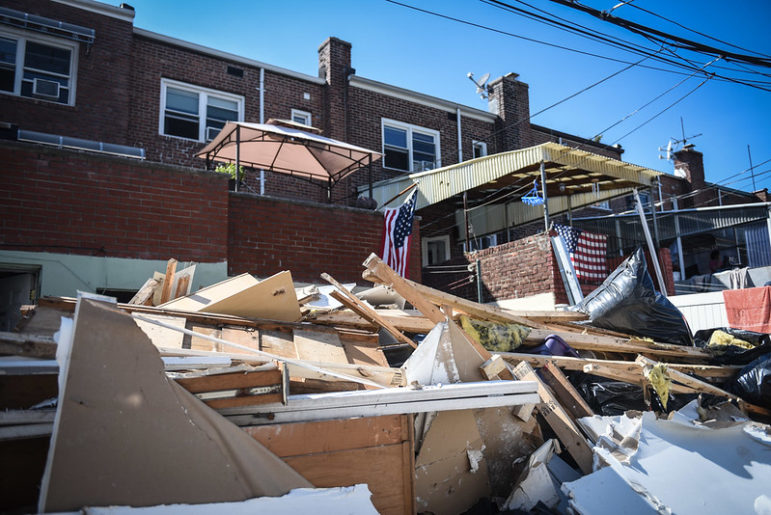Cash assistance has been dispersed to 288 households so far, for a total of $1,601,210: 345 applications have been finalized and 201 are still being processed. Stakeholders say it’s unlikely the fund will open again to applicants.

Michael Appleton/Mayoral Photography Office
Ida aftermath in Queens.Lea la versión en español aquí.
More than seven months after Hurricane Ida flooded New York’s streets, the state fund created for impacted undocumented immigrants and others ineligible for federal aid has dispersed just under $2 million after closing April 29—just a portion of the $27 million officials set aside for it.
The Hurricane Ida Relief Fund has closed and been extended several times, running synchronously with Federal Emergency Management Agency (FEMA) application periods. During the last application period from February to April, only 36 additional applications were received, bringing the total to 546 applications since the fund launched in September 2021, Gov. Kathy Hochul’s office reported. The city and state created the program to help storm victims who were ineligible for FEMA relief aid, including those excluded from federal assistance because of their immigration status. During the most recent extension period, 18 people applied were eligible for FEMA help and referred there instead, officials said.
Cash assistance has been dispersed to 288 households so far, for a total of $1,601,210. 345 applications have been finalized and 201 that are still being processed. So far, Queens county residents have gotten the most relief funding, followed by those living in Westchester and Brooklyn.
Carola Otero Bracco, executive director of Neighbors Link, one of the six Community-Based Organizations (CBOs) selected to administer and distribute the fund, says his group alone has dispersed about $220,000 to applicants in Westchester where they are based. More than 14 percent of those who received funding so far were from Westchester County.
| Ida Fund Distribution | ||
| County | Amount | Percent |
| Bronx | $104,682 | 6.5 |
| Queens: | $1,048,403 | 65.4 |
| Nassau: | $57,981 | 3.6 |
| Brooklyn | $126,588 | 7.9 |
| Staten Island: | $19,861 | 1.2 |
| Rockland: | $2,194 | 0.1 |
| Suffolk: | $5,947 | 0.3 |
| Westchester: | $235,553 | 14.7 |
| Total | $1,601,209 | 99.7 |
Slow rollout
When asked why disbursement amount was so slow, the community-based organizations administering the funds explained that there are multiple checks to go through before an applicant can access the funding. “Getting funds into the hands of people who need it after a disaster is arguably never fast enough,” said Julianne Pannelli, director of special projects at Catholic Charities Community Services (CCCS).
“It takes time for households to provide supporting documents, time for Case Managers to review those documents and complete claim forms, time for Supervisors to approve and submit those claim forms, time for the agency to cut checks, and time for Case Managers to set up appointments with clients to disburse the funds,” she detailed by email.
Documenting losses has also been difficult for applicants, the organizations insisted. The Ida relief program provided a maximum of $72,000 per eligible household (up to $36,000 in grants for housing-related assistance and up to $36,000 in assistance for other needs). But this aid was not announced until 25 days after Ida’s remnants hit New York, so affected people were focused on surviving in the immediate aftermath of the storm, rather than documenting every step of their loss.
“Due to the program being announced a month later, applicants move out and are no longer living at the damaged property, and therefore it is difficult to prove need and displacement,” said Steve Mei, director of CPC Brooklyn Community Services, another nonprofit administering the fund.
Shane Yu, special project associate at MinKwon Center for Community Action who was in charge of their Chinese-language applicants, noted that fear of applying for government assistance may also have prevented people from applying. About 11 people who qualified and had started the application process later withdrew it, Yu said.
The time between application and disbursement has not been the most efficient either. Days before the first application deadline (Nov. 26, 2021), only 32 applicants had received funds and as of December, 66 had received them, as previously reported by City Limits. Organizations don’t have an average estimate of how long it would take for an applicant to receive money, saying that it all depended on what aid they had applied for.
For example, Yu said that it could take a person up to two or three months to get funds; Pannelli estimated that the average is about 3 weeks, from the time of receipt of all documents to disbursement.
“The process may take up to a month,” said Mei, throwing another variable to consider: method of payment. “Time can be determined by method of payment, direct deposit, debit cards, etc.”
The vast majority of cash assistance distributed so far, $1,212,634, has gone to the “other needs assistance” category, which covers things such as vehicle damage, moving expenses, and childcare. And very few applications have received direct housing-related assistance, accounting for just $388,575 of the dispersed funds.
According to the Department of State, applicants across the state had received an average payment of about $5,555 at this time. A little more than $3 million of the $27 million would be used if this average amount continues to be dispersed to the remainder of those who applied.
End of the road?
The application period has closed, but organizations will continue to work on the program. According to the Department of State, 201 applications are still being processed. However, this extension appears to be the last.
“The extension period that just ended did not give a sense of additional needs and the providers did not request another extension,” said Mercedes Padilla, a spokesperson for New York’s Department of State.
Organizations such as CCCS agreed. “At this time, it doesn’t appear that a program extension is necessary,” said Pannelli.
But there would still be almost all of the fund’s money left unused. Organizations distributing the dollars are pushing to either make the fund permanent to assist future storm victims, or to divert the unused funds to a program that assists the same undocumented population.
Mei said that he had met with the Commissioner of the Mayor’s Office of Immigrant Affairs, Manuel Castro last month. “We spoke to about the Ida Relief Fund, and he understood that there is money left that needs to be given out to assist our community members,” he said.
When asked, state officials said it was too soon to decide what to do with the remaining money. “At this time we are focused on assisting individuals who were impacted. It is too early to determine how much of the overall funds will be awarded as the process continues,” said Padilla.
And as for the money remaining, officials said that the 2023 enacted budget places the leftover funds in the Department of State’s budget to respond to all applications received.









